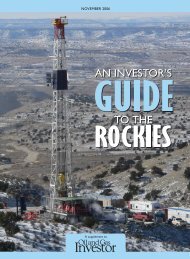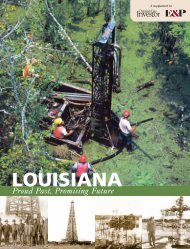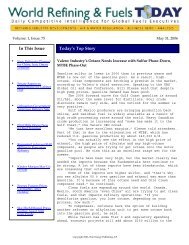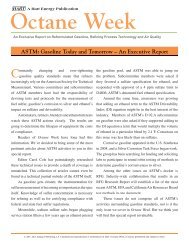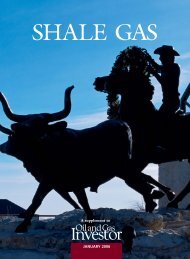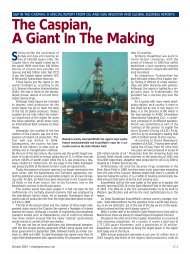download pdf - Oil and Gas Investor
download pdf - Oil and Gas Investor
download pdf - Oil and Gas Investor
You also want an ePaper? Increase the reach of your titles
YUMPU automatically turns print PDFs into web optimized ePapers that Google loves.
CANADIAN<br />
INVESTMENT<br />
OPPORTUNITIES<br />
A Special Report from
The experience you expect.<br />
The results you deserve.<br />
Selected Transactions Since January 2003<br />
$51,100,000<br />
Common Stock<br />
Follow-On Offering<br />
$530,300,000<br />
Common Stock<br />
Private Placement<br />
Pengrowth Energy Trust<br />
$113,000,000<br />
Trust Unit<br />
Follow-On Offering<br />
Evergreen Resources, Inc.<br />
$200,000,000<br />
5.875% Senior<br />
Subordinated Notes<br />
Lead Manager<br />
April 2004<br />
Co-Lead Manager<br />
March 2004<br />
Lead Manager<br />
March 2004<br />
Co-Manager<br />
March 2004<br />
Tortoise Energy Infrastructure Corp.<br />
$316,000,000<br />
Common Stock<br />
Initial Public Offering<br />
Co-Lead Manager<br />
February 2004<br />
Chesapeake Energy Corporation<br />
$270,200,000<br />
Common Stock<br />
Follow-On Offering<br />
Co-Manager<br />
January 2004<br />
$78,600,000<br />
Advantage Energy Income Fund<br />
has acquired<br />
MarkWest Resources Canada<br />
from MarkWest Hydrocarbon, Inc.<br />
Financial Advisor to<br />
MarkWest<br />
November 2003<br />
$90,700,000<br />
Carbon Energy Corp.<br />
has been acquired by<br />
Evergreen Resources Inc.<br />
Financial Advisor to<br />
Carbon Energy Corp.<br />
October 2003<br />
Tom Brown, Inc.<br />
$281,319,000<br />
Common Stock<br />
Follow-On Offering<br />
EnCana Corporation<br />
$1,010,000,000<br />
Canadian <strong>Oil</strong> S<strong>and</strong>s Trust has<br />
acquired a 13.75% Syncrude Interest<br />
from EnCana Corporation<br />
$109,100,000<br />
Common Stock<br />
Follow-On Offering<br />
$575,000,000<br />
Common Stock<br />
Follow-On Offering<br />
Co-Manager<br />
September 2003<br />
Financial Advisor to<br />
EnCana Corporation<br />
June 2003<br />
Lead Manager<br />
February 2003<br />
Co-Manager<br />
January 2003<br />
RBC Capital Markets is one of North America's leading<br />
energy <strong>and</strong> power investment banks. With equal strengths<br />
in both the Canadian <strong>and</strong> U.S. markets, we have played a<br />
significant role in all major energy <strong>and</strong> power transactions.<br />
Since January 2003, we have raised more than $12 billion<br />
for the sector through 88 transacitons. Put our experience<br />
to work for you.<br />
Look to our industry professionals for<br />
the results you deserve.<br />
www.rbccm.com/energy<br />
Communications, Media & Entertainment • Consumer • Diversified • Energy • Financial Institutions • Forest Products • Healthcare • Mining <strong>and</strong> Metals • Real Estate • Technology<br />
This announcement appears as a matter of record only. RBC Capital Markets is the global br<strong>and</strong> name for the corporate <strong>and</strong> investment banking businesses of Royal Bank of Canada <strong>and</strong> its affiliates, including RBC Capital Markets<br />
Corporation in the U.S., member SIPC; <strong>and</strong> RBC Dominion Securities Inc. in Canada, member CIPF. TM trademark of Royal Bank of Canada. RBC Capital Markets is a trademark of Royal Bank of Canada, used under license.
SPECIAL REPORT: CANADIAN INVESTMENT OPPORTUNITIES<br />
Canadian Returns<br />
With meeting new reserves definitions behind them,<br />
as a result of NI 51-101, many Canadian producers<br />
are resuming their business of portfolio growth,<br />
while some have put themselves on the market.<br />
Calgary-based investor-relations <strong>and</strong> consulting firm<br />
Iradesso Communications reports that since January 1, more<br />
than a dozen among the 68 Canadian producers that began<br />
the year have since been purchased or merged <strong>and</strong> 15 new<br />
ones have been formed.<br />
“The usual life-cycle of a junior in western Canada is<br />
three to five years, with production growth from zero to<br />
1,000 or 2,000 BOE (barrels of oil equivalent) per day…The<br />
management normally parachutes out of the transaction <strong>and</strong><br />
starts again,” Peter Knapp, Iradesso president, writes in<br />
“Canadian Juniors” in this special report on Canada.<br />
Start-ups are being purchased by royalty trusts or in some<br />
cases by U.S. independents that are looking for growth opportunities<br />
in the Western Canadian Sedimentary Basin.<br />
U.S. companies have been net sellers, however, <strong>and</strong> some<br />
are finding their assets fetching tremendous premiums. In<br />
one recent transaction, the western Canadian divestment by<br />
U.S.-based Murphy <strong>Oil</strong>, the buyers paid historically high<br />
prices: an implied average of C$18 per proved BOE (after royalties).<br />
Paul Cheng, an analyst with Lehman Brothers, calls it<br />
“an alarming high price.”<br />
Knapp says, “If oil <strong>and</strong> gas prices continue to stay at historically<br />
high levels, these trusts will continue to enjoy exceptional<br />
access to capital <strong>and</strong> will use that to buy up<br />
juniors to replace their reserves <strong>and</strong> production. Conversely,<br />
if commodity prices were to weaken for a sustained period,<br />
the royalty trusts would need to deal with lower distributions<br />
<strong>and</strong> cash flow.”<br />
Analysts with Calgary-based investment-banking firm<br />
FirstEnery Capital Corp. report, “The valuations of Canadian<br />
junior <strong>and</strong> midcaps are influenced by expectations of<br />
CONTENTS<br />
C-5 CALGARY START-UPS<br />
They form, grow, sell or merge, <strong>and</strong> start anew.<br />
Here’s a spotlight on some of Canada’s newest<br />
E&P companies.<br />
C-9 ALBERTA’S CBM<br />
The development of Canadian coalbed methane<br />
centers in Alberta, <strong>and</strong> this year promises to be the<br />
province’s busiest yet.<br />
C-11 CANADIAN JUNIORS<br />
Canadian junior oil <strong>and</strong> gas companies are exciting<br />
to watch, <strong>and</strong> even more exciting to participate in.<br />
C-15 THE VIEW FROM CALGARY<br />
To supply the insatiable U.S. dem<strong>and</strong> for oil <strong>and</strong><br />
gas, Canadian producers are creatively trying to<br />
beat their own decline curves.<br />
12-Month <strong>Oil</strong> & <strong>Gas</strong> Trust Total Returns*<br />
Harvest<br />
Petrofund<br />
Vermilion<br />
Enerplus<br />
ARC<br />
Advantage<br />
Focus<br />
Pengrowth<br />
Acclaim<br />
S&P TSE Index<br />
S&P TSE Energy Index<br />
Shiningbank<br />
Canadian <strong>Oil</strong> S<strong>and</strong>s<br />
PrimeWest<br />
Provident<br />
Paramount<br />
0 10 20 30 40 50 60 70 80<br />
Percent<br />
Three-Month <strong>Oil</strong> & <strong>Gas</strong> Trust Total Returns*<br />
Crescent Point<br />
Vermilion<br />
Peyto<br />
Harvest<br />
Advantage<br />
Bonavista<br />
ARC<br />
Baytex<br />
S&P TSE Energy Index<br />
Acclaim<br />
S&P TSE Index<br />
Paramount<br />
Focus<br />
Enerplus<br />
PrimeWest<br />
Shiningbank<br />
Canadian <strong>Oil</strong> S<strong>and</strong>s<br />
Provident<br />
Petrofund<br />
Pengrowth<br />
-15 -10 -5 0 5 10 15 20 25<br />
Percent<br />
* Through 3-31-04<br />
Source: FirstEnergy Capital Corp., Calgary<br />
royalty trust-type metrics either by way of reorganizing or<br />
acquisition. The Canadian environment is even more competitive<br />
than the U.S. market.”<br />
Consolidation among trusts is expected, as not all trusts<br />
are performing equally. The royalty trusts’ total returns during<br />
the first quarter of 2004 have been disappointing, compared<br />
with their 12-month returns, according to William<br />
Lacey, one of the FirstEnergy analysts.<br />
“What hasn’t helped are the interest-rate concerns out<br />
there,” Lacey says. U.S. Federal Reserve Chairman Alan<br />
Greenspan is hinting that the U.S. federal funds rate may be<br />
pushed higher in coming months. Trusts compete with<br />
money-market <strong>and</strong> other secure investments for dollars.<br />
Some trust investors are getting skittish that they may need<br />
to redirect their assets.<br />
But it would take a significant upward push in interest<br />
rates to make cash investments more attractive: the 12-<br />
month total returns (unit-price improvement plus distributions<br />
through March 31, 2004) of the 14 Canadian trusts<br />
that Lacey covers have ranged from 74% to 13%. In this<br />
range, trusts’ competition would be more likely with loanshark<br />
investing.<br />
“<strong>Investor</strong>s should be more concerned with commodity<br />
prices,” Lacey says. The market price for oil <strong>and</strong> gas more<br />
greatly affect royalty trusts’ total returns than interest rates.<br />
—Nissa Darbonne,<br />
Executive Editor<br />
June 2004 ▪ <strong>Oil</strong> <strong>and</strong> <strong>Gas</strong> <strong>Investor</strong> C-3
Providing blanket coverage<br />
of Western Canada<br />
Wood Mackenzie is announcing the launch of<br />
its new Western Canada upstream service.<br />
In conjunction with Wood Mackenzie's coverage<br />
of Canada's Frontiers, the Western Canada<br />
upstream service is a powerful reference <strong>and</strong><br />
analytical tool for any company either active in or<br />
evaluating potential opportunities in the region.<br />
Our product suite <strong>and</strong> comprehensive Western<br />
Canada database allows the user to:<br />
› Identify key areas of exploration <strong>and</strong><br />
production growth<br />
› Benchmark company activities<br />
across a range of metrics<br />
› Generate competitor positions <strong>and</strong><br />
compare assets <strong>and</strong> infrastructure<br />
› Run company <strong>and</strong> asset valuations<br />
To receive the Western Canada<br />
upstream service brochure email<br />
energy@woodmac.com<br />
For fur ther inform ation visit:<br />
www.woodmac.com/westerncanada<br />
US Helpdesk<br />
T +1 713 470 1700<br />
E energy @ woodmac.co m
CANADIAN E&P<br />
Calgary Start-Ups<br />
New E&P companies are finding plenty of growing room in western Canada.<br />
ARTICLE BY BRIAN A. TOAL<br />
F<br />
or energy pundits who believe North America is an<br />
overworked, mature basin that’s literally <strong>and</strong> figuratively<br />
running out of gas, there’s a plethora of emerging Calgary<br />
junior oils, private <strong>and</strong> public, that see just the converse<br />
in Canada’s Western Sedimentary Basin.<br />
True, the so-called “one-well wonders” may no longer<br />
abound in much of Alberta’s Foothills area or northeast<br />
British Columbia as they once did.<br />
But the use of horizontal drilling, 3-D seismic <strong>and</strong> wellstimulation<br />
technologies is helping small operators drill up<br />
plays that were economically out of their reach years ago.<br />
Also, most of today’s emerging junior Canadian oils are<br />
being helmed by seasoned management teams that have the<br />
desire <strong>and</strong> know-how to replicate much of their past production<br />
<strong>and</strong> reserve growth.<br />
Indeed, one such new Calgary producer, Duvernay <strong>Oil</strong><br />
Corp., headed by the former management team of Berkley<br />
Petroleum Corp., is already outpacing the daily output <strong>and</strong><br />
in-ground inventory growth achieved by Berkley itself during<br />
its first 30 months of operations in Canada’s western basin.<br />
Meanwhile, Calgary start-up MEG Energy Corp. is taking<br />
a patient approach to building its<br />
position in the world-class, oils<strong>and</strong>-laden<br />
Athabasca Fairway.<br />
There, it expects by 2006 to begin<br />
drilling, which shortly thereafter<br />
could lead to daily oil output of<br />
25,000 barrels—a level of production<br />
usually associated only with<br />
intermediate-size oils.<br />
In short, there are plenty of untapped<br />
drilling opportunities still<br />
left in western Canada. It just<br />
takes a little more patience <strong>and</strong><br />
seasoned skill to go after them—<br />
that <strong>and</strong> a judicious use of technology<br />
to lower finding <strong>and</strong><br />
development costs to manageable<br />
levels.<br />
Exploration still key<br />
When it comes to drilling in<br />
the Western Canadian Sedimentary<br />
Basin, Michael L. Rose, president<br />
<strong>and</strong> chief executive officer<br />
of newly public Duvernay <strong>Oil</strong><br />
Corp. (Toronto: DDV), is no<br />
stranger to successfully tapping<br />
the region’s various play types.<br />
In 1993, he <strong>and</strong> a group of ex-<br />
Shell Canada explorationists<br />
Mike Rose started another Canadian E&P company, Duvernay<br />
<strong>Oil</strong> Corp., after selling Berkley Petroleum to Anadarko.<br />
started Berkley Petroleum Corp. with C$11 million of private<br />
equity <strong>and</strong> bank debt. That same year, Berkley went<br />
public <strong>and</strong> began in earnest to zero in on the basin’s vast oil<br />
<strong>and</strong> gas potential. That effort translated into remarkable reserve<br />
<strong>and</strong> production growth—so remarkable that by March<br />
2001, Berkley sold out to Anadarko Petroleum Corp. for<br />
C$1.5 billion.<br />
One would think a nearly 136-fold return on investment<br />
would have sated the aspirations of almost any producer. But<br />
not Rose. By July 2001, he formed privately held Duvernay,<br />
<strong>and</strong> two months later, funded it with C$60 million of private-equity<br />
backing led by Peters & Co.<br />
“If you’re a petroleum geologist, there’s nothing more exciting<br />
than finding new oil <strong>and</strong> gas pools <strong>and</strong> having the satisfaction<br />
of being right <strong>and</strong> creating value,” says Rose.<br />
“Besides, the team we brought over from Berkley, which includes<br />
Bob Yurkovich, our vice president of exploration, is<br />
still relatively young <strong>and</strong> really doesn’t know how to do anything<br />
else.”<br />
Such a b<strong>and</strong> of explorers really doesn’t need to know how<br />
to do anything else. With the September 2001 private funding<br />
it received, Duvernay—a<br />
name derived from the source<br />
rock responsible for most of the<br />
Devonian-age oil <strong>and</strong> gas accumulations<br />
in western Canada—has<br />
grown daily hydrocarbon output<br />
from zero to north of 6,000 barrels<br />
of oil equivalent (BOE).<br />
Proved reserves, meanwhile,<br />
climbed from zero to 18.7 million<br />
BOE by year-end 2003. Add<br />
proved plus probable reserves <strong>and</strong><br />
that asset base swells to 25 million<br />
BOE.<br />
This rapid growth—well ahead<br />
of Berkley’s pace after 2.5 years—<br />
has been largely accomplished by<br />
accelerated drilling along a broad<br />
trend extending from Wild River-<br />
Sundance in north-central Alberta<br />
to Groundbirch-Sunset in<br />
northeast British Columbia. The<br />
play areas in northern Alberta<br />
also include Peace River High,<br />
Fir, Spirit River <strong>and</strong> Dawson-<br />
Puskwa.<br />
Duvernay’s drilling in these<br />
areas has ramped up from one well<br />
in late 2001 to 20 wells in 2002<br />
<strong>and</strong> 40 wells in 2003. Total capex<br />
June 2004 ▪ <strong>Oil</strong> <strong>and</strong> <strong>Gas</strong> <strong>Investor</strong> C-5
during this period was north of<br />
C$200 million. In 2004, the producer,<br />
whose C$52.5-million<br />
IPO this February was led to market<br />
by Peters & Co., plans to<br />
spend an initial C$80 million to<br />
drill 50 to 60 wells.<br />
“In the Wild River area, we’ve<br />
made light-oil discoveries in the<br />
Jurassic <strong>and</strong> gas finds in the Cretaceous;<br />
in the Puskwa area, the<br />
oil <strong>and</strong> gas finds have occurred in<br />
the Devonian <strong>and</strong> Mississippian;<br />
in the Groundbirch <strong>and</strong> Sunset<br />
areas, they’ve all been in the Triassic,”<br />
says Rose. “All these formations<br />
occur at depths between<br />
5,000 <strong>and</strong> 10,000 feet.”<br />
The biggest of Duvernay’s<br />
finds to date have occurred at<br />
Groundbirch—a tight-s<strong>and</strong> gas<br />
discovery with more than 100<br />
billion cubic feet (Bcf) of reserve<br />
potential—<strong>and</strong> Wild River, a<br />
light-oil <strong>and</strong> gas discovery which<br />
may have 5- to 10 million barrels<br />
of oil in place <strong>and</strong> about 50 Bcf<br />
of gas, including all the uphole zones.<br />
“We operate almost all our wells <strong>and</strong><br />
are much more focused than we were at<br />
Berkley,” says Rose. “The major areas<br />
we’re in are all geologically contiguous;<br />
that allows operations to be run with a<br />
smaller staff. In fact, we run all of our<br />
field operations out of just one office, in<br />
Fort St. John in northeast British<br />
Columbia.”<br />
In addition, the exploration-focused<br />
junior oil, with a market cap of C$420<br />
million, has staffed up in t<strong>and</strong>em with<br />
its growth rather than growing, then<br />
having to scramble for more h<strong>and</strong>s.<br />
“Also, as the result of having the best of<br />
the Berkley staff, we’ve learned from<br />
our past mistakes—we’re more patient<br />
<strong>and</strong> better at predicting where our reserves<br />
<strong>and</strong> production are going to be.”<br />
Applying new frac technology to its<br />
tight-s<strong>and</strong> gas wells is also helping the<br />
company grow output. Says Rose, “In<br />
many cases, it has meant the difference<br />
between not producing anything <strong>and</strong><br />
having commercial wells.”<br />
Not relying solely on repeatable development<br />
opportunities, Duvernay’s<br />
inventory of 50 to 60 planned wells this<br />
year includes 13 to 15 high-impact exploratory<br />
wildcats in its core areas.<br />
“With the well-defined exploration<br />
<strong>and</strong> development program we have, we<br />
can easily see ourselves growing corearea<br />
daily production beyond 10,000<br />
BOE within the next 18 months,” says<br />
Rose.<br />
“After that, there’s still lots of oil <strong>and</strong><br />
J.C. Anderson launched Anderson Energy Ltd. shortly after<br />
selling Anderson Exploration Inc. to Devon Energy Corp.<br />
gas to be found in western Canada, including<br />
the largely unexplored Northwest<br />
Territories, from Fort Liard all the<br />
way up to the Mackenzie Delta. The<br />
number of large, new-pool discoveries<br />
there is quite high relative to the number<br />
of wells drilled.”<br />
Eschewing acquisitions<br />
Another seasoned explorationist who<br />
knows his way around western Canada<br />
is J. C. Anderson, chairman of privately<br />
held Anderson Energy Ltd., a 2002 entrant<br />
to the Calgary E&P scene.<br />
Anderson is the former head of Anderson<br />
Exploration Inc., a producer<br />
that itself was private for some 20 years<br />
before going public in 1988. That’s<br />
when its growth through the drillbit in<br />
the Western Canadian Sedimentary<br />
Basin really took off. In October 2001,<br />
the Nebraska-born Anderson sold his<br />
namesake company—then producing<br />
“We think that natural<br />
gas is the game to play.”<br />
J.C. Anderson,<br />
Anderson Energy Ltd.<br />
about 210,000 BOE per day—to<br />
Devon Energy for C$7.1 billion,<br />
including the assumption of debt.<br />
“However, when we sold to<br />
Devon, I didn’t feel like I was<br />
done playing the exploration<br />
game—not when there were still<br />
plenty of drilling opportunities left<br />
in western Canada,” says Anderson.<br />
“On top of that, there were<br />
some super, like-minded people<br />
from Anderson Exploration who<br />
felt we could pull together a successful<br />
new E&P company.”<br />
By May 2002, Anderson Energy<br />
Ltd. got off the ground with C$80<br />
million of funding. Among the<br />
founding shareholders were seven<br />
former senior Anderson Exploration<br />
executives <strong>and</strong> directors including<br />
Brian Dau, the new<br />
company’s president <strong>and</strong> chief executive<br />
officer; Darlene Wong, its<br />
chief financial officer; Anderson<br />
himself; <strong>and</strong> two executives who<br />
joined the firm from other oil<br />
companies. Collectively, this group<br />
owns a 28% stake in the upstream startup.<br />
Other financial backers include additional<br />
members of the Anderson family<br />
who hold a 16% interest, Canadian <strong>and</strong><br />
U.S. institutional investors which have<br />
a 34% interest, <strong>and</strong> friends <strong>and</strong> associates<br />
who have a combined 22% stake.<br />
“When we started Anderson Energy,<br />
all of us thought that we were going to<br />
spend about half the raised capital on<br />
acquisitions because a number of the<br />
larger oil companies were then selling<br />
off properties,” says Anderson.<br />
“However, the prices that were being<br />
paid for oil <strong>and</strong> gas properties by Canadian<br />
royalty trusts just ballooned out of<br />
sight, so we chose not to compete. Very<br />
simply, we’re not interested in annuities.”<br />
As a result, the company’s strategic<br />
emphasis shifted almost exclusively to<br />
growth through exploration drilling.<br />
The core focus: the Sierra <strong>and</strong> Chinchauga<br />
areas in northeast British<br />
Columbia where gas prospects are in<br />
Devonian carbonate sediments, 5,000<br />
to 10,000 feet deep; an 1,800-foot shallow-gas<br />
play in northeastern Alberta focused<br />
on Devonian carbonates <strong>and</strong><br />
Cretaceous s<strong>and</strong>s; a 3,000- to 4,000-<br />
foot gas play northwest of Edmonton<br />
involving Cretaceous <strong>and</strong> Triassic<br />
s<strong>and</strong>s; <strong>and</strong> Mississippian-subcrop <strong>and</strong><br />
Cretaceous channel-s<strong>and</strong> oil prospects,<br />
down to 8,500 feet, south of Calgary.<br />
“We think that natural gas is the<br />
C-6 <strong>Oil</strong> <strong>and</strong> <strong>Gas</strong> <strong>Investor</strong> ▪ June 2004
game to play,” says Anderson. “Commodity<br />
prices have gone up significantly<br />
<strong>and</strong> are likely to stay there. The<br />
fact is, North American producers are<br />
having a hard time replacing production—<strong>and</strong><br />
that bodes well for future gas<br />
prices.”<br />
While the company’s current production<br />
is only 1,500 BOE per day, it fully<br />
expects daily output to ramp up significantly<br />
by 2005.<br />
“We’ve just come off a successful<br />
winter drilling program, primarily in<br />
northeast British Columbia, but we’re<br />
in the early stages of exploration <strong>and</strong><br />
those wells which successfully found<br />
natural gas won’t be on production<br />
until next year,” Anderson says. “So our<br />
numbers are going to change significantly.”<br />
He cautions, however, that current<br />
<strong>and</strong> future drilling successes won’t be<br />
one-well wonders or out-of-the-park<br />
home runs.<br />
“As a general rule, we expect our<br />
finds to be the sort that give us plenty<br />
of room to run after a discovery is made,<br />
in terms of being able to drill a lot of<br />
development wells to grow our production<br />
base.”<br />
What is also going to help the startup<br />
efficiently grow not only production,<br />
but also reserves, is its use of horizontal<br />
drilling, 3-D seismic <strong>and</strong> well-stimulation<br />
technologies.<br />
“These are all things that make<br />
smaller targets—which were uneconomic<br />
10 to 15 years ago—very much<br />
economic today,” he says. “With these<br />
technologies, we’re able to more fully<br />
explore a particular zone with fewer<br />
rigs, get the kind of deliverability we<br />
need, <strong>and</strong> keep finding <strong>and</strong> development<br />
costs low.”<br />
Will this newcomer ultimately grow<br />
to the size of Anderson Exploration?<br />
“Right now, I’m just interested in seeing<br />
us, two or three years out, increase<br />
daily production to 10,000 BOE or<br />
more,” he says.<br />
Big-barrel target<br />
Bill McCaffrey, president <strong>and</strong> chief<br />
executive officer of privately held MEG<br />
Energy Corp., also brought a lot of upstream<br />
knowledge to the table when he<br />
<strong>and</strong> two other partners—Dave Wizinsky<br />
<strong>and</strong> Steven Turner—formed their<br />
March 1999 start-up.<br />
During his prior 18 years with<br />
Amoco Canada, McCaffrey was at one<br />
point responsible for the growth of the<br />
company’s largest oil-s<strong>and</strong>s project in<br />
western Canada—the Primrose project<br />
in northeastern Alberta’s Cold Lake<br />
“Additional sources<br />
of [oil] supply are in<br />
decline plus dem<strong>and</strong><br />
throughout the world<br />
continues to grow,<br />
particularly in China.”<br />
Bill McCaffrey,<br />
MEG Energy Corp.<br />
area, south of the Athabasca Fairway.<br />
“At the time we formed MEG, oil<br />
prices were around US$10 per barrel,<br />
<strong>and</strong> most people felt prices were going<br />
to remain low for a long time,” says Mc-<br />
Caffrey. “We saw this as an opportunity<br />
at a countercyclical point in the industry<br />
to link our experience with a very<br />
large growth prospect close to U.S.<br />
markets.”<br />
That not unfamiliar growth prospect<br />
is the Athabasca Fairway, which has<br />
one of the largest oil-s<strong>and</strong>s deposits in<br />
the world. According to U.S. Geological<br />
Survey estimates, the bitumen deposits<br />
there contain more than 175<br />
billion barrels of recoverable oil reserves.<br />
Taking aim at that resource potential,<br />
the start-up firm in 1999 acquired<br />
within that fairway 5,000 acres, on<br />
which existing wells identified the presence<br />
of oil-s<strong>and</strong>s deposits. Since then,<br />
the company has greatly enlarged its<br />
Athabasca Fairway oil-s<strong>and</strong>s lease position,<br />
to 33,000 acres—100% owned<br />
<strong>and</strong> contiguous.<br />
This holding is adjacent to EnCana<br />
Corp.’s Christina Lake thermal-oil-recovery<br />
project, which has initial daily<br />
oil production of 5,000 barrels.<br />
“Meanwhile, we’ve also drilled 68<br />
core holes on this lease which have<br />
helped us characterize its resource potential<br />
<strong>and</strong> allowed us to begin identifying<br />
where the best pay zones are<br />
located,” says McCaffrey.<br />
“In t<strong>and</strong>em, we’ve also shot more<br />
than 22 miles of 2-D seismic <strong>and</strong> 12<br />
miles of 3-D in order to put together a<br />
geologic model of the oil-s<strong>and</strong>s-bearing<br />
formations.”<br />
The company’s aim is to begin commercial<br />
development of the lease in<br />
2007—using steam-assisted gravity<br />
drainage (SAGD) technology—<strong>and</strong> to<br />
produce 25,000 barrels of oil per day by<br />
2008.<br />
The SAGD process involves drilling<br />
a series of horizontal well pairs—parallel<br />
to each other—down through the<br />
overburden into the oil-s<strong>and</strong>s formation,<br />
which in this case is some 1,200<br />
feet below the surface, explains McCaffrey.<br />
Steam from a central surface facility<br />
is then injected into the upper horizontal<br />
well, creating a steam chamber <strong>and</strong><br />
allowing the heated oil in the formation<br />
to drain down to the lower horizontal<br />
well. Lift mechanisms are then<br />
used to get the heated oil in the lower<br />
well out of the ground into separation,<br />
tank-battery <strong>and</strong> pipeline facilities.<br />
To ensure sufficient funding is available<br />
for such an ambitious, capital-intensive<br />
drilling project, the private<br />
start-up this February got the crossborder<br />
backing of New York-based Warburg<br />
Pincus, which is providing C$59<br />
million of private equity.<br />
“The fact that we had already built<br />
up a strong leasehold position, have a<br />
strong management team in place <strong>and</strong><br />
enormous resource growth potential in<br />
front of us were clearly factors attractive<br />
to Warburg,” says Dale Hohm,<br />
MEG chief financial officer.<br />
Attractive, too, is the composition of<br />
MEG’s board. It includes Alan<br />
Archibald, formerly a senior executive<br />
with Anderson Exploration before successfully<br />
growing Westpoint Energy <strong>and</strong><br />
Tripoint Energy—two other private<br />
Calgary producers.<br />
Also on MEG’s board is Paul Rady,<br />
chairman <strong>and</strong> chief executive officer of<br />
Denver’s Antero Resources Corp., another<br />
Warburg Pincus-backed private<br />
operator; Whitney Ward, a former<br />
global partner with Invesco in Denver;<br />
<strong>and</strong> Lloyd Swift, a former vice president<br />
with Nesbitt Burns in Calgary.<br />
McCaffrey believes the fundamentals<br />
for continuing high oil prices in North<br />
America are very strong. “Additional<br />
sources of supply are in decline plus dem<strong>and</strong><br />
throughout the world continues<br />
to grow, particularly in China.”<br />
While an initial 25,000 barrels per<br />
day of oil output from the company’s<br />
planned drilling program would catapult<br />
it to the ranks of an intermediate<br />
Canadian producer, “we see significant<br />
upside beyond that as we advance<br />
through further phases of development<br />
on our lease,” McCaffrey says. <br />
June 2004 ▪ <strong>Oil</strong> <strong>and</strong> <strong>Gas</strong> <strong>Investor</strong> C-7
Resource plays.<br />
They set us apart.<br />
Our asset base, our core competencies, our track record <strong>and</strong> our<br />
culture, they all come together in our resource plays* - a foundation<br />
of our production growth potential.<br />
Our resource play assets typically have a long life, low production costs<br />
<strong>and</strong> low decline profiles <strong>and</strong> have provided steady, reliable <strong>and</strong> highly<br />
profitable production growth. Resource plays make up the majority of our<br />
North American assets.<br />
With an enterprise value of approximately US$25 billion, EnCana is one of<br />
the world's leading independent oil <strong>and</strong> gas companies <strong>and</strong> is driven to be<br />
the industry's high performance benchmark in production cost, per-share<br />
growth <strong>and</strong> value creation. EnCana common shares trade on the Toronto <strong>and</strong><br />
New York stock exchange under the symbol ECA.<br />
* Resource play is a term used by EnCana to describe an accumulation of hydrocarbons known to exist over a<br />
large areal expanse <strong>and</strong>/or thick vertical section, which when compared to a conventional play, typically has a<br />
lower geological <strong>and</strong>/or commercial development risk <strong>and</strong> lower average decline rate.<br />
www.encana.com
COALBED METHANE<br />
Alberta’s CBM<br />
Like to western Canada’s south, operators are finding ways to economically<br />
produce shallow coalbed methane.<br />
ARTICLE BY PEGGY WILLIAMS<br />
T<br />
he development of coalbed methane (CBM) in Canada<br />
centers in Alberta, <strong>and</strong> this year promises to be the<br />
province’s busiest yet in this exp<strong>and</strong>ing source of gas.<br />
At year-end 2003, some 780 CBM wells had been drilled in<br />
Alberta, another 80 wells targeted a mixture of coals <strong>and</strong><br />
s<strong>and</strong>s, <strong>and</strong> 155 existing wells were recompleted as CBM<br />
wells, reports the Alberta Energy & Utilities Board (EUB).<br />
The top play—the target of 80% of the total wells—is in<br />
south-central Alberta’s Upper Cretaceous Horseshoe<br />
Canyon/Belly River coals, part of the Drumheller coal zone.<br />
Located northeast of Calgary <strong>and</strong> stretching to Edmonton,<br />
this prospective area features low-rank coals that occur in<br />
discontinuous seams at depths between 1,000 <strong>and</strong> 3,000 feet.<br />
Significantly, these coals produce very little to no water, a<br />
tremendous attribute that greatly reduces operating costs <strong>and</strong><br />
environmental issues.<br />
The two most active players in the Horseshoe Canyon<br />
have been EnCana Corp. <strong>and</strong> Quicksilver Resources Inc.<br />
The companies initially had a joint venture in the Palliser<br />
area but dissolved that partnership early in 2003.<br />
Last year, following the success of a 35-well pilot project<br />
that produced 3 million cubic feet of gas per day, EnCana<br />
drilled 270 wells in its Palliser program. It approaches these<br />
coals much like it does a conventional shallow-gas play,<br />
using the same rigs <strong>and</strong> multi-zone<br />
fracturing techniques.<br />
In 2004, EnCana plans to drill<br />
about 300 wells on its 700,000 acres of<br />
prospective properties, raising production<br />
by year-end to 30 million cubic Prairie<br />
Gr<strong>and</strong>e<br />
feet per day. During the next five<br />
years, it estimates that its CBM production<br />
from this play could reach 200<br />
million cubic feet per day.<br />
Fort Worth-based independent<br />
Quicksilver, which operates in Canada<br />
through its MGV Energy Inc. subsidiary,<br />
also continues to aggressively<br />
develop CBM production in the area.<br />
“We <strong>and</strong> our partners have drilled<br />
Index Map<br />
more than 200 wells <strong>and</strong> we believe<br />
we have defined a significant fairway<br />
for coalbed methane,” Glenn Darden,<br />
president <strong>and</strong> chief executive officer,<br />
said at a recent IPAA-sponsored investment<br />
conference.<br />
Currently the company is producing<br />
22 million cubic feet of CBM gas per<br />
day in Canada from a series of joint<br />
ventures with partners including<br />
ConocoPhillips, Enerplus, NCE Petrofund,<br />
Burlington Resources <strong>and</strong> Murphy <strong>Oil</strong>. Quicksilver operates<br />
95% of these projects, <strong>and</strong> altogether holds 525,000<br />
net acres of leases.<br />
The company booked proved reserves of 132 billion cubic<br />
feet from these properties at year-end 2003, <strong>and</strong> it expects to<br />
double that number in 2004, Darden said. This year, Quicksilver<br />
will drill 285 net CBM wells in Alberta <strong>and</strong> expects to<br />
exit 2004 with Canadian CBM production of 35 million<br />
cubic feet per day.<br />
“This project now, we can clearly see, can be a trillioncubic-foot<br />
project for us. And with luck we can double that<br />
number.”<br />
The rates of return in the Horseshoe Canyon play are<br />
compelling: the shallow CBM wells, which average production<br />
rates of 140,000 cubic feet per day <strong>and</strong> reserves of 450<br />
million cubic feet, deliver 60% rates of return at gas prices of<br />
US$4 per thous<strong>and</strong> cubic feet, <strong>and</strong> post nearly 100% return<br />
at prices of US$5 per thous<strong>and</strong>.<br />
Apache Canada also has an active CBM campaign in the<br />
same play, centered in its Nevis Field area northeast of Red<br />
Deer, where it holds 250 sections of l<strong>and</strong>. It drilled 16 wells during<br />
first-quarter 2004, raising its total number of CBM wells to<br />
121 <strong>and</strong> its related production to 16 million cubic feet of gas per<br />
day. During 2004, it expects to drill about 250 wells in the play.<br />
6th 5th 4th M<br />
ALBERTA<br />
Red Deer<br />
Calgary<br />
Edmonton<br />
Medicine<br />
Hat<br />
Distribution of net coal 10-25m, Ardley coal zone,<br />
Scollard Formation.<br />
Distribution of net coal 4-18m, Drumheller coal zone.<br />
Horseshoe Canyon Formation.<br />
Distribution of net coal 4-12 m at depths less than<br />
1500m, Manville coal zone.<br />
The two most active players in the Horseshoe<br />
Canyon have been EnCana Corp. <strong>and</strong> Quicksilver<br />
Resources Inc.<br />
30<br />
20<br />
10<br />
80<br />
70<br />
60<br />
50<br />
40<br />
30<br />
20<br />
10<br />
While the economic viability of<br />
CBM production from Alberta’s dry<br />
coal zones is now established, the same<br />
cannot yet be said for the province’s<br />
extensive wet coals.<br />
Of these more problematic targets,<br />
interest is focused on coals in the older<br />
Mannville Group <strong>and</strong> in the Ardley<br />
coal zone, a younger coal that is part of<br />
the Scollard Formation.<br />
About 140 wells have been drilled<br />
to test the Mannville coals, which produce<br />
copious amounts of saline water.<br />
These seams are coincident with part<br />
of the Drumheller coals <strong>and</strong> also extend<br />
farther east.<br />
Less than 50 of the Mannville tests<br />
are producing gas, reports the EUB.<br />
And, the Ardley coals, which occur to<br />
the north <strong>and</strong> west of Calgary, have<br />
been very lightly tested to date. About<br />
60 wells had been drilled to the Ardley<br />
zone through 2003, <strong>and</strong> only a h<strong>and</strong>ful<br />
of these are on production. Like the<br />
Mannville, the Ardley coals produce<br />
water, but the volumes <strong>and</strong> salinities<br />
can vary widely.<br />
June 2004 ▪ <strong>Oil</strong> <strong>and</strong> <strong>Gas</strong> <strong>Investor</strong> C-9
The Emerging Exploration <strong>and</strong> Growth Company of 2004<br />
• Focused Western Canadian Operations<br />
• Large World-Class Offshore Nova Scotia <strong>and</strong> Trinidad Prospects<br />
• Strong Balance Sheet<br />
• Experienced Management Team<br />
Growth In:<br />
Financial Results<br />
Production<br />
Reserve Value<br />
People (Talent)<br />
High Impact Plays<br />
SNG<br />
Canadian Superior Energy Inc.<br />
Suite 3300, 400-3rd Avenue S.W.<br />
Calgary, Alberta<br />
Canada T2P 4H2<br />
Phone: 403-294-1411<br />
Fax: 403-216-2374<br />
Stock Symbol - SNG: TSX, AMEX<br />
Website: www.cansup.com
PUBLIC EQUITY<br />
Canadian Juniors<br />
Publicly held entrepreneurial E&Ps merge or are bought out, <strong>and</strong> new ones keep popping up. Here’s how<br />
to evaluate them as investments.<br />
ARTICLE BY PETER KNAPP<br />
The fate of<br />
the junior<br />
sector will<br />
undoubtedly<br />
be tied to the<br />
intermediate<br />
royalty trust<br />
sector.<br />
C<br />
anadian junior oil <strong>and</strong> gas companies are exciting to<br />
watch, <strong>and</strong> even more exciting to participate in. <strong>Investor</strong>s<br />
who do their homework by researching company<br />
fundamentals, growth prospects <strong>and</strong> the caliber of<br />
management can make money<br />
in this sector. More<br />
than 70 publicly listed<br />
juniors are focused<br />
on exploration <strong>and</strong><br />
production in<br />
western Canada,<br />
mostly from a base<br />
in Calgary.<br />
This year some<br />
of them will see<br />
their share price<br />
double, triple <strong>and</strong><br />
do better. There<br />
will also be some<br />
disappointments.<br />
A number of companies<br />
will be acquired<br />
or reorganized, <strong>and</strong> a new<br />
crop will continue to take their place.<br />
This thriving sector runs in cycles<br />
driven by commodity prices, but its fate is<br />
also connected with exit strategies <strong>and</strong> management<br />
teams that keep returning under new<br />
company names. These teams don’t just enjoy the game of<br />
building small oil <strong>and</strong> gas companies to a point where they<br />
can sell them; they can also make a significant amount of<br />
money doing so.<br />
Fortunately, so can shareholders.<br />
We define juniors as those with production averaging between<br />
500 <strong>and</strong> 15,000 barrels of oil equivalent (BOE) per<br />
day. Although a number of companies in this range are private,<br />
the majority trade on the Toronto Stock Exchange<br />
(TSX) or the Toronto Venture Exchange (TSXV). Market<br />
capitalization of each of the 71 public juniors ranges<br />
from C$15- to C$600 million. The<br />
whole junior sector has an aggregate<br />
market cap of approximately<br />
C$9 billion.<br />
Companies with less<br />
than 500 BOE per day of<br />
production are called<br />
emerging, <strong>and</strong><br />
larger companies<br />
are referred<br />
to<br />
as either<br />
interme-<br />
diates or<br />
seniors.<br />
But in the<br />
past three years,<br />
the intermediate<br />
sector has evolved to a<br />
point where it is almost exclusively<br />
populated by royalty<br />
trusts. Because they continually distribute a large<br />
percentage of their cash flow to unit-holders, they are much<br />
less active as explorers <strong>and</strong> aggressive drillers than intermedi-<br />
June 2004 ▪ <strong>Oil</strong> <strong>and</strong> <strong>Gas</strong> <strong>Investor</strong> C-11
ate companies have been in the past.<br />
This has helped the juniors rediscover<br />
their niche as they have been<br />
picking up the slack. They have also<br />
become feedstock for the trusts that use<br />
their tremendous access to capital to<br />
buy up junior companies at a rate of<br />
five to 10 per quarter.<br />
As a group, the juniors seem to favor<br />
gas production over crude oil. <strong>Gas</strong> can<br />
be produced with comparably lower operating<br />
costs, while the prices received<br />
are often relatively higher than those<br />
received for oil. Some of the companies<br />
that had the highest proportion of their<br />
fourth-quarter 2003 production<br />
weighted to gas include Hawker Resources<br />
(Toronto: HKR) at 100%,<br />
Ketch Resources (Toronto: KER) at<br />
94% <strong>and</strong> Diaz Resources (Toronto:<br />
DZR.A) at 88%.<br />
One company that has found success<br />
while bucking this trend is Blackrock<br />
Resources (Toronto: BVI) with 100%<br />
of production made up of heavy oil.<br />
An extended period of high commodity<br />
prices has benefited the Canadian<br />
juniors <strong>and</strong> their investors. During<br />
2003, juniors showed an average return<br />
of 63.5%. Only 15% experienced a<br />
share-price decrease, while one in four<br />
saw its share price rise 100%.<br />
By comparison, the 17 Canadian energy<br />
trusts that make up the intermediate<br />
sector had total returns, including<br />
distributions, averaging 49% for 2003.<br />
That included an 18% average return<br />
from distributions paid during the year<br />
as well as a 31% average gain in unit<br />
prices.<br />
In the first four months of 2004, the<br />
market for juniors appeared to be catching<br />
its breath, with only a 2% average<br />
share-price increase during this period.<br />
Valuations, key metrics<br />
<strong>Investor</strong>s in junior companies, <strong>and</strong><br />
often the executives of these companies<br />
themselves, frequently compare companies’<br />
financial <strong>and</strong> operating results<br />
against each other to make more informed<br />
investment decisions.<br />
However, in a recent survey Iradesso<br />
Communications found that the quality<br />
of the management team is the most<br />
important factor for investment decisions.<br />
Of course, this is impossible to<br />
objectify, although a past record of success<br />
or failure is as close as one can<br />
come.<br />
Another key factor that cannot be<br />
found in the comparison of investment<br />
ratios or multiples is the quality of future<br />
growth prospects. This means some<br />
companies end up trading at much<br />
Canadian Juniors<br />
Distribution By Daily Production<br />
50<br />
Number of Companies<br />
40<br />
30<br />
20<br />
10<br />
0<br />
41<br />
500<br />
to<br />
2,000<br />
15<br />
2,001<br />
to<br />
3,500<br />
7<br />
3,501<br />
to<br />
5,000<br />
5,001<br />
to<br />
6,500<br />
BOE/d<br />
6,501<br />
to<br />
8,000<br />
8,001<br />
to<br />
9,500 >9,500<br />
During 2003, juniors<br />
showed an average return<br />
of 63.5%….[<strong>and</strong>]<br />
one in four saw its share<br />
price rise 100%.<br />
4<br />
1<br />
2<br />
1<br />
higher multiples because future growth<br />
is already factored into their share<br />
price.<br />
Reserves volumes <strong>and</strong> present values<br />
are evaluated by third-party engineering<br />
firms <strong>and</strong> reported by Canadian juniors<br />
on an annual basis. However,<br />
some companies are starting to report<br />
reserves quarterly to recognize growth<br />
<strong>and</strong> lower the chance of any surprises.<br />
Starting with year-end 2003 reporting,<br />
the Canadian Securities Administrators<br />
implemented National<br />
Instrument 51-101 to ensure consistent<br />
reserve definitions are used across the<br />
board by public Canadian oil <strong>and</strong> gas<br />
companies, while attempting to enhance<br />
investor confidence in Canadian<br />
capital markets.<br />
Under the definitions of reserves set<br />
out by NI 51-101, a company’s reserves<br />
should have a 90% probability of being<br />
greater than the proved reserves assigned<br />
to the company, <strong>and</strong> a 50%<br />
probability of being greater than the<br />
proved plus probable reserves assigned.<br />
Of the 71 juniors currently operating,<br />
55 had released their year-end 2003 results<br />
at press time. For those 55 companies<br />
we were able to calculate a blowdown<br />
net asset value by taking the 10%<br />
discounted net present value of reserves,<br />
adding C$100 per acre for undeveloped<br />
l<strong>and</strong>, adding working capital<br />
<strong>and</strong> subtracting debt.<br />
After dividing this by the number of<br />
shares outst<strong>and</strong>ing, we found that as of<br />
April 30, 2004, 80% of companies were<br />
trading at a premium to our blow-down<br />
net asset value (NAV) calculation.<br />
This high percentage could be a result<br />
of conservative pricing forecasts used to<br />
calculate the present value of reserves.<br />
It could also be a result of investors attributing<br />
value to strong management<br />
teams <strong>and</strong> post-2003 growth prospects.<br />
Using the year-end reserve reports,<br />
we can compare the enterprise value<br />
(market cap plus net debt) less undeveloped<br />
l<strong>and</strong> value, attributed to each<br />
BOE of reserves. This calculation gives<br />
us an average value of C$24.45 per<br />
BOE of proved reserves <strong>and</strong> C$17.53<br />
per BOE of proved plus probable reserves.<br />
Companies that appeared to offer<br />
good value using this measure include<br />
Ranchgate Energy (Toronto: ROG) at<br />
C$7.52 per BOE, Purcell Energy<br />
(Toronto: PEL) at C$8.39 <strong>and</strong> Connacher<br />
at C$8.43 (all on a provedplus-probable<br />
basis).<br />
Cash flow multiples are also a favorite<br />
valuation tool. Rather than use<br />
a straight share price, or market cap<br />
multiple of cash flow, it is more effective<br />
to use enterprise value multiples,<br />
which incorporate net debt. Otherwise<br />
a company that carries a comparably<br />
large amount of debt could appear<br />
falsely undervalued to potential investors.<br />
Cash flow multiples can be<br />
monitored quarterly <strong>and</strong> also be projected<br />
into the future with a forecast of<br />
cash flow.<br />
On a historical basis, by the end of<br />
April, companies were trading with an<br />
average enterprise value 14.3 times<br />
their 2003 cash flow. A more valuable<br />
measure will be the enterprise multiple<br />
of cash flow for first-quarter 2004 annualized.<br />
It is likely that companies that<br />
had a low enterprise multiple of cash<br />
flow for 2003 will continue to report<br />
this in 2004 <strong>and</strong> therefore will look like<br />
a strong potential investment. These<br />
companies include Devlan Exploration<br />
(Toronto: DXI) at 4.7 times, Case Resources<br />
(Toronto: CAZ) at 5.4 <strong>and</strong> Energy<br />
North (Toronto: ENI) at 5.8.<br />
Debt levels are monitored by investors<br />
as another multiple of cash flow.<br />
Most companies strive to have net debt<br />
C-12 <strong>Oil</strong> <strong>and</strong> <strong>Gas</strong> <strong>Investor</strong> ▪ June 2004
The bank of energy<br />
has an extensive knowledge of the industry<br />
is a powerful ally through economic swings<br />
executes complex transactions with agility <strong>and</strong> expertise<br />
customizes financing around your specific needs<br />
puts its full energy behind each <strong>and</strong> every deal.<br />
SM<br />
Invest in you<br />
Energy Capital Services<br />
Dallas - (214) 922-4200 Calgary, Canada Branch * - (403) 264-2700<br />
Carl Stutzman, Senior Vice President<br />
James G. Chepyha, Vice President<br />
R<strong>and</strong>all L. Osterberg, Senior Vice President<br />
Dustin <strong>Gas</strong>pari, Vice President<br />
Damien Meiburger, Senior Vice President<br />
Mezzanine Finance **<br />
Michael Ross, Vice President, (213) 236-6061<br />
©2003 Union Bank of California, N.A. Member FDIC<br />
*Union Bank of California, N.A., does not accept deposits from the public in Canada <strong>and</strong> is not a member institution of the Canada Deposit Insurance Corporation.<br />
**Mezzanine loans are made pursuant to a Department of Corporations California Finance Lenders License by UnionBanCal Equities, Inc., an affiliate of Union Bank of California, N.A.
of less than 1.5 times annualized cash<br />
flow, <strong>and</strong> companies carrying higher<br />
debt than this are often penalized by<br />
the market. Among the cycles experienced<br />
by the sector is availability of<br />
capital. The past year has been good<br />
for access to capital, as many junior<br />
companies have been able to successfully<br />
conduct secondary share<br />
offerings.<br />
Exit strategies<br />
Iradesso’s quarterly report on<br />
Canadian junior companies attempts<br />
to compare all companies<br />
that meet the criteria. The last report,<br />
issued at the beginning of December<br />
2003, included 68 companies.<br />
In the last four months, 13 of these<br />
companies have disappeared or are in<br />
the process of disappearing, while at<br />
least 15 new companies have filled the<br />
void. This translates into a turnover<br />
rate of approximately 20% in less than<br />
half a year.<br />
The 13 companies that most recently<br />
disappeared have all been acquired,<br />
mostly in friendly takeovers by royalty<br />
trusts, or they have converted to a royalty<br />
trust.<br />
The usual life-cycle of a junior in<br />
western Canada is three to five years,<br />
with production growth from zero to<br />
1,000 or 2,000 BOE per day. After this<br />
time, the company is often acquired or<br />
merged with another. The management<br />
normally parachutes out of the transaction<br />
<strong>and</strong> starts again. In recent years,<br />
this has been done through a spin-off<br />
company that takes some of the more<br />
growth-oriented assets as a starter kit.<br />
The spin-off transaction seems to<br />
have been mastered by the management<br />
team led by Paul Colborne. This<br />
team began this type of transaction<br />
when Startech Energy was sold to ARC<br />
Commodity Focus of Canadian Juniors<br />
Natural <strong>Gas</strong><br />
Focused<br />
(>35% gas)<br />
48%<br />
As a group, the juniors<br />
seem to favor gas production<br />
over crude oil.<br />
<strong>Oil</strong> Focused<br />
(>65% oil)<br />
16%<br />
Balanced<br />
Production<br />
Mix<br />
36%<br />
Energy Trust in early 2001 <strong>and</strong> spun off<br />
Impact Energy. Most recently, when<br />
Crescent Point Energy merged with<br />
Tappit Resources to form Crescent<br />
Point Energy Trust (Toronto:<br />
CPG.UN), shareholders received shares<br />
in a new spin-off, Starpoint Energy<br />
(Toronto: SPN).<br />
Selling the company to a royalty<br />
trust hasn’t always been the most common<br />
exit strategy for juniors. During<br />
2000, there was a cycle involving U.S.<br />
exploration <strong>and</strong> production companies<br />
Researching Canadian Juniors<br />
For more information on the Canadian junior oil <strong>and</strong> gas sector, you may wish<br />
to visit the following web sites:<br />
• Canadian Association of Petroleum Producers (CAPP): www.capp.ca<br />
• <strong>Oil</strong>patch Updates: www.oilpatchupdates.com<br />
• System for Electronic Document Analysis <strong>and</strong> Retrieval (equivalent to<br />
EDGAR in the U.S.): www.sedar.com<br />
• Small Explorers <strong>and</strong> Producers Association of Canada (SEPAC):<br />
www.sepac.com<br />
• Alberta Securities Commission (disclosure st<strong>and</strong>ards): www.albertasecurities.com<br />
• TSX Group: www.tsx.com<br />
• Iradesso Communications Corp.: www.iradesso.com<br />
• Canada Stockwatch: www.canada-stockwatch.com<br />
acquiring Canadian companies with a<br />
focus on securing access to junior oil<br />
<strong>and</strong> gas reserves. In 2001, when gas<br />
prices declined, many of these acquisitions<br />
started looking expensive, so U.S.<br />
companaies have shied away from acquiring<br />
Canadian juniors since.<br />
What’s next?<br />
As any investor in the oil <strong>and</strong><br />
gas sector should know, the next<br />
phase of the cycle is often determined<br />
by what happens to commodity<br />
prices.<br />
The fate of the junior sector will<br />
also be tied to the intermediate royalty<br />
trust sector. If oil <strong>and</strong> gas prices<br />
continue to stay at historically high<br />
levels, these trusts will continue to<br />
enjoy exceptional access to capital <strong>and</strong><br />
will use that to buy up juniors to replace<br />
their reserves <strong>and</strong> production.<br />
Conversely, if commodity prices were<br />
to weaken for a sustained period, the<br />
royalty trusts would need to deal with<br />
lower distributions to unit-holders <strong>and</strong><br />
lower cash flow.<br />
This could lead to a period of consolidation<br />
within the royalty trust sector,<br />
while junior oil <strong>and</strong> gas companies<br />
maintain themselves on their own cash<br />
flow. A shake-out of the junior <strong>and</strong> intermediate<br />
sectors could be healthy,<br />
<strong>and</strong> those that make it through a lowerprice<br />
cycle will be much stronger coming<br />
out the other side.<br />
Another possibility presumes American<br />
companies once again make their<br />
presence felt by acquiring Canadian<br />
companies. This has happened approximately<br />
every few years in the past, <strong>and</strong><br />
the time may be due for this trend to<br />
emerge once again.<br />
The model for building a junior oil<br />
<strong>and</strong> gas company will undoubtedly continue<br />
to evolve. It may do so to take advantage<br />
of new technologies available<br />
to smaller companies such as those involved<br />
in producing coalbed methane<br />
or shallow oil s<strong>and</strong>s. They may also<br />
evolve to take advantage of new <strong>and</strong><br />
improved financial structures, such as<br />
the case was for royalty trusts.<br />
Canada’s junior sector is filled with<br />
growth stories <strong>and</strong> competent management<br />
teams, <strong>and</strong> will continue to be a<br />
fascinating (<strong>and</strong> hopefully profitable)<br />
sector to watch.<br />
Peter Knapp is president of Iradesso<br />
Communications Corp., a Calgary-based<br />
investment research, investor relations <strong>and</strong><br />
corporate communications firm. The firm<br />
represents some of the companies mentioned<br />
in this article.<br />
C-14 <strong>Oil</strong> <strong>and</strong> <strong>Gas</strong> <strong>Investor</strong> ▪ June 2004
PRODUCERS’ OUTLOOK<br />
The View from Calgary<br />
Upstream activity in Canada’s Western Sedimentary Basin is at full throttle.<br />
INTERVIEW BY BRIAN A. TOAL<br />
With so much uncertainty today<br />
surrounding the stability of<br />
global oil <strong>and</strong> gas supply,<br />
Canada is being viewed more <strong>and</strong> more<br />
as a safe harbor for the U.S, in terms of<br />
meeting rising energy dem<strong>and</strong>, particularly<br />
as that dem<strong>and</strong> relates to natural<br />
gas.<br />
Indeed, Canada is the largest foreign<br />
gas supplier to the U.S., currently exporting<br />
3.4 trillion cubic feet (Tcf) of<br />
gas annually to the Lower 48. Put another<br />
way, about 15% of all the natural<br />
gas consumed in the U.S. comes from<br />
Canada.<br />
Meanwhile, during this time of turmoil<br />
in Iraq <strong>and</strong> other parts of the Middle<br />
East, security of oil supply is also<br />
looming as a much larger issue for the<br />
U.S. There again, Canada has the potential<br />
to allay much of that concern,<br />
given its massive oil-s<strong>and</strong>s deposits, recently<br />
estimated at 175 billion barrels.<br />
These petroleum deposits are, in fact,<br />
the largest in the world behind those of<br />
Saudi Arabia.<br />
To find out more about Canada’s<br />
current <strong>and</strong> future hydrocarbon supply picture <strong>and</strong> the breadth of<br />
its recent upstream activity, <strong>Oil</strong> <strong>and</strong> <strong>Gas</strong> <strong>Investor</strong> recently met<br />
with Greg Stringham, vice president of markets <strong>and</strong> fiscal policy<br />
for the Canadian Association of Petroleum Producers (CAPP) in<br />
Calgary.<br />
A nearly 20-year veteran of the Maple Leaf oil patch, Stringham<br />
began his career with Syncrude, the 12-company consortium<br />
that runs the giant Canadian oil-s<strong>and</strong>s project in northeast Alberta.<br />
He also worked several years for the Alberta provincial<br />
government on energy-policy issues before joining CAPP eight<br />
years ago.<br />
<strong>Investor</strong> What was the level of drilling activity in Canada<br />
last year <strong>and</strong> what’s the outlook for it this year?<br />
Stringham Canadian rig activity in 2003 reached record levels.<br />
Overall, there were nearly 20,000 wells drilled, most of<br />
them for natural gas. Comparatively, first-quarter drilling this<br />
year was up 37% from the same prior-year period <strong>and</strong> up 91%<br />
from the comparable 2002 period.<br />
In 2004, gas drilling will still dominate the rig count, accounting<br />
for some 15,000 wells out of an expected 20,000-<br />
plus total well count.<br />
<strong>Investor</strong> What about annual production growth?<br />
Stringham <strong>Gas</strong> output was down slightly in 2003 from the<br />
average 6.3 Tcf we produce in Canada annually. However, as<br />
Greg Stringham, vice president, markets <strong>and</strong> fiscal<br />
policy, Canadian Association of Petroleum Producers<br />
(CAPP) in Calgary, says it would take—at current<br />
production rates—about 400 years to deplete<br />
western Canada’s known oil-s<strong>and</strong> reserves.<br />
the result of record drilling activity<br />
in first-quarter 2004, we see annual<br />
gas output this year climbing back to<br />
around 6.3 Tcf.<br />
<strong>Investor</strong> And on the oil side of the<br />
equation?<br />
Stringham Our average crude oil output—2.5<br />
million barrels per day—<br />
was up slightly last year because a<br />
major oil-s<strong>and</strong>s project, Shell Albian<br />
in northeastern Alberta, came onstream.<br />
In fact, by the end of 2003, 1<br />
million barrels per day of crude output<br />
was coming from Canadian oils<strong>and</strong>s<br />
production alone.<br />
This year, we expect Canada’s<br />
overall daily crude output to grow<br />
further, in no small part propped by<br />
increasing oil-s<strong>and</strong>s production,<br />
which is expected to reach 1.8 million<br />
barrels per day by 2010.<br />
One should remember that in<br />
western Canada, there’s an estimated<br />
175 billion barrels of oil-s<strong>and</strong>s reserves<br />
in the ground. To put this immense<br />
reserve base in perspective, it<br />
would take—at current production<br />
rates at our existing oil-s<strong>and</strong>s operations—about 400 years to<br />
deplete those reserves.<br />
<strong>Investor</strong> On the gas side, where is most of the drilling in<br />
western Canada taking place?<br />
Stringham The highest gas-producing wells are being drilled<br />
right along the Foothills Front in northern Alberta <strong>and</strong><br />
northeast British Columbia; however, the largest number of<br />
gas wells—about 65% of the 15,000 wells I mentioned—are<br />
being drilled in the shallow-gas regions of southwestern Alberta<br />
<strong>and</strong> southwestern Saskatchewan.<br />
<strong>Investor</strong> What’s the remaining gas resource base in Canada?<br />
Stringham There’s an estimated 363 Tcf of remaining gas resource<br />
potential. Importantly, this figure does not include an<br />
estimated 167 Tcf of untapped natural gas potential from<br />
Canadian coalbed-methane (CBM) resources.<br />
Fewer than 800 CBM wells have been drilled in Canada in<br />
the past 20 years; however, there’s likely to be 1,150 wells<br />
drilled in 2004, ramping up to 1,500 in 2005.<br />
<strong>Investor</strong> What has the recent Canadian gas-export picture<br />
looked like, with respect to the U.S.?<br />
Stringham On average, we export annually to the U.S. some<br />
3.4 Tcf of gas—more than half our yearly domestic output of<br />
6.3 Tcf. Last year, however, those exports were down slightly<br />
due to several factors.<br />
June 2004 ▪ oil<strong>and</strong>gasinvestor.com C-15
International<br />
Natural <strong>Gas</strong><br />
Energy<br />
Service Industry<br />
Acquisitions<br />
Exploration<br />
Midstream<br />
Wind Power<br />
Conventional<br />
Align<br />
your<br />
Resources<br />
Capitalize<br />
on<br />
your<br />
Energy<br />
We bridge the Energy Sector,<br />
bringing investors <strong>and</strong> industry<br />
players together with the right<br />
advice <strong>and</strong> the best service.<br />
• We help Energy Companies<br />
raise private capital <strong>and</strong><br />
complete sound mergers<br />
<strong>and</strong> acquisitions.<br />
• We offer Capital Providers<br />
solid investment strategy<br />
<strong>and</strong> execution.<br />
Mezzanine<br />
Equity Grou<br />
Financiers<br />
Investment Bankers<br />
Private Capital<br />
Mutual Funds<br />
Hedge Fun<br />
Gate Keepers<br />
<strong>Investor</strong>s<br />
www.coscocap.com<br />
New York • Hartford • Houston<br />
Tulsa • Oklahoma City • Calgary<br />
To Capitalize on<br />
your Energy, contact:<br />
Cameron O. Smith<br />
Sr. Managing Director, New York NY<br />
212-889-0206 cos@coscocap.com<br />
William E. Weidner<br />
Managing Director, Avon CT<br />
860-677-6345 wew@coscocap.com<br />
Lane W. McKay<br />
Managing Director, Calgary AB<br />
403-237-9462 lwm@coscocap.com<br />
T. Prescott (Scott) Kessey<br />
Principal, Houston TX<br />
713-654-8080 tpk@coscocap.com
Natural <strong>Gas</strong> Wells Drilled in Western Canada<br />
18,000<br />
15,000<br />
12,000<br />
9,000<br />
6,000<br />
3,000<br />
Coalbed Methane Wells (NGC)<br />
Drilled in Western Canada<br />
CBM wells in Canada<br />
2000<br />
1600<br />
1200<br />
800<br />
400<br />
0<br />
1990 1992 1994 1996 1998 2000 2002 2004E<br />
0<br />
1977-1999<br />
2000-2003 2004E 2005E<br />
Since 1990, the number of natural gas wells drilled in western Canada has steadily climbed <strong>and</strong><br />
should account for 15,000 of the total 20,000 wells expected in 2004.<br />
Source: CAPP<br />
There are likely to be 1,150 CBM wells drilled in<br />
2004, ramping up to 1,500 in 2005.<br />
Source: CAPP<br />
First, overall U.S. gas dem<strong>and</strong> was<br />
down about 5% in 2003 at the same<br />
time Canadian gas production was also<br />
down slightly. Meanwhile, with the<br />
start-up of the Kern River Pipeline from<br />
the U.S. Rockies, some of the Canadian<br />
gas that would normally go into<br />
California went into storage in Canada<br />
by mid-year.<br />
This past winter, however, that supply<br />
came back to meet the severe cold<br />
snap in the U.S. Northwest. So the capacity<br />
is there to meet U.S. gas dem<strong>and</strong>—not<br />
just now but in the<br />
future—from the resource potential I’ve<br />
already mentioned.<br />
I would also point out that prospects<br />
for pipelining Arctic gas from Canada’s<br />
Mackenzie Delta into the vast Canadian<br />
<strong>and</strong> U.S. pipeline network look<br />
promising. An application for a<br />
pipeline through the Mackenzie Delta<br />
is expected in mid-2004, with gas flowing<br />
by late 2008 or early 2009.<br />
<strong>Investor</strong> What about oil exports to the<br />
U.S.?<br />
Stringham Of the overall 2.5 million<br />
barrels per day produced in Canada,<br />
some 1.6 million barrels is exported to<br />
the U.S. I would add that we expect<br />
conventional oil production off<br />
Canada’s East Coast—currently<br />
330,000 barrels per day—to grow to<br />
nearly 500,000 daily barrels by 2006<br />
when White Rose joins the existing Hibernia<br />
<strong>and</strong> Terra Nova projects.<br />
<strong>Investor</strong> What’s the biggest challenge<br />
currently facing the Canadian oil <strong>and</strong><br />
gas industry?<br />
Stringham Access to resources, timely<br />
regulatory processes <strong>and</strong> implementing<br />
new technology to lower costs are, of<br />
course, key factors for Canadian producers.<br />
But equally important is access<br />
to markets—ensuring sufficient<br />
pipeline capacity for oil <strong>and</strong> gas to get<br />
where those commodities are needed.<br />
For natural gas, current pipeline capacity<br />
is sufficient <strong>and</strong> diversified<br />
enough that Canadian gas can move<br />
to markets domestically <strong>and</strong> in the<br />
U.S., as market dem<strong>and</strong> changes. For<br />
oil, while a few small pipeline expansions<br />
are under way, the anticipated<br />
huge growth in oil-s<strong>and</strong>s production<br />
that I mentioned between now <strong>and</strong><br />
2010 is leading to significant analysis<br />
as to what markets this growth will be<br />
targeted.<br />
While the U.S. is an obvious market,<br />
we’ve also had inquiries about directing<br />
some of our growing oil-s<strong>and</strong>s supply to<br />
places like China, Taiwan <strong>and</strong> Korea.<br />
<strong>Investor</strong> How much capital infusion or<br />
upstream spending are you seeing<br />
within the Canadian E&P sector?<br />
Stringham Investment in the Canadian<br />
oil <strong>and</strong> gas sector is close to, if not at,<br />
record levels. For instance, in 2003, we<br />
saw some US$20 billion invested in the<br />
upstream—most of that coming from<br />
the cash flows of producers; the balance,<br />
from the Canadian financial markets.<br />
<strong>Investor</strong> Do you see any step-up in<br />
M&A activity this year, particularly<br />
crossborder transactions?<br />
Stringham We had a very large influx<br />
of U.S. investment around 2001 with<br />
Burlington acquiring Canadian Hunter,<br />
Anadarko acquiring Berkley <strong>and</strong> Devon<br />
acquiring Anderson. Future activity<br />
like that, however, depends on many<br />
factors, including one’s perception of<br />
the maturity of Canada’s western basin.<br />
We view the basin as relatively<br />
young versus the U.S., at least on the<br />
natural gas side. In fact, if one compares<br />
Canada’s western basin with the<br />
Anadarko Basin, the Permian Basin<br />
<strong>and</strong> the onshore U.S. Gulf Coast, we’re<br />
about 12 to 15 years behind, in terms of<br />
maturity.<br />
Also, crossborder M&A activity depends<br />
on currency-exchange rates, the<br />
prospects for CBM, oil-s<strong>and</strong>s development<br />
<strong>and</strong> the timing of bringing on<br />
Mackenzie Delta gas—from an initial 1<br />
billion cubic feet (Bcf) per day to as<br />
much as 1.8 to 2 Bcf per day.<br />
But let’s not forget, although much of<br />
the publicized crossborder M&A deals<br />
in recent years has spotlighted U.S.<br />
producers acquiring Calgary operators,<br />
the deal flow works the other way as<br />
well, as we saw this April with EnCana<br />
Corp.’s agreement to buy Tom Brown<br />
Inc. for US$2.7 billion.<br />
<strong>Investor</strong> What’s the biggest thing you<br />
think North American producers <strong>and</strong><br />
investors should underst<strong>and</strong> about the<br />
Canadian oil <strong>and</strong> gas industry?<br />
Stringham That Canada is, <strong>and</strong> will<br />
continue to be, a vital part of U.S.<br />
energy supply. Natural gas exports<br />
from Canada to the U.S. have, in<br />
fact, doubled during the past decade<br />
<strong>and</strong> while they’ve flattened out recently,<br />
don’t assume they’re going to<br />
be falling off.<br />
Canadian CBM <strong>and</strong> Mackenzie Delta<br />
gas output have not even been touched<br />
yet. Also, as I mentioned, oil-s<strong>and</strong>s production<br />
in northern Alberta is growing<br />
quickly.<br />
The important thing to note is that<br />
the oil <strong>and</strong> gas trade between Canada<br />
<strong>and</strong> the U.S. is working very well. It is,<br />
in fact, a model from which other countries<br />
can learn a great deal. <br />
June 2004 ▪ <strong>Oil</strong> <strong>and</strong> <strong>Gas</strong> <strong>Investor</strong> C-17
The Canadian Association of Petroleum Producers’ (CAPP) annual<br />
<strong>Oil</strong> & <strong>Gas</strong> Investment Symposium takes place each June in Calgary,<br />
Alberta. It provides an unrivalled opportunity for institutional<br />
investors to meet senior management from Canada's leading<br />
oil <strong>and</strong> gas producers as well as the emerging companies<br />
that generate so much interest in the sector.<br />
OIL&GAS<br />
INVESTMENT<br />
SYMPOSIUM<br />
June 14–15, 2004<br />
This year, we have made BIG changes.<br />
We value your feedback.<br />
communication@capp.ca<br />
<strong>and</strong> www.capp.ca<br />
2100, 350 - 7 Avenue SW<br />
Calgary, Alberta<br />
Canada T2P 3N9<br />
Telephone: (403) 267-1100<br />
Fax: (403) 261-4622<br />
230, 1801 Hollis Street<br />
Halifax, Nova Scotia<br />
Canada B3J 3N4<br />
Telephone: (902) 420-9084<br />
Fax: (902) 491-2980<br />
905, 235 Water Street<br />
St. John’s, Newfoundl<strong>and</strong><br />
Canada A1C 1B6<br />
Telephone: (709) 724-4200<br />
Fax: (709) 724-4225<br />
After extensive research <strong>and</strong> polling, we have reinvigorated the<br />
conference to ensure that it is a must-attend event. We have<br />
enhanced the networking opportunities, added roundtable<br />
discussions with corporate executives <strong>and</strong> a CEO issues<br />
forum. Improvements will continue in 2005.<br />
CAPP is the voice of Canada’s upstream petroleum industry <strong>and</strong><br />
Investment Symposium is where our members tell their stories.<br />
CAPP represents 150 companies that explore for, develop <strong>and</strong><br />
produce more than 98 per cent of Canada’s natural gas <strong>and</strong> crude<br />
oil. CAPP also has 125 associate member companies that provide<br />
a wide range of services that support the upstream oil <strong>and</strong> natural<br />
gas industry. Together, these members <strong>and</strong> associate members are<br />
an important part of a $75-billion-a-year national industry that<br />
affects the livelihoods of more than half a million Canadians.



